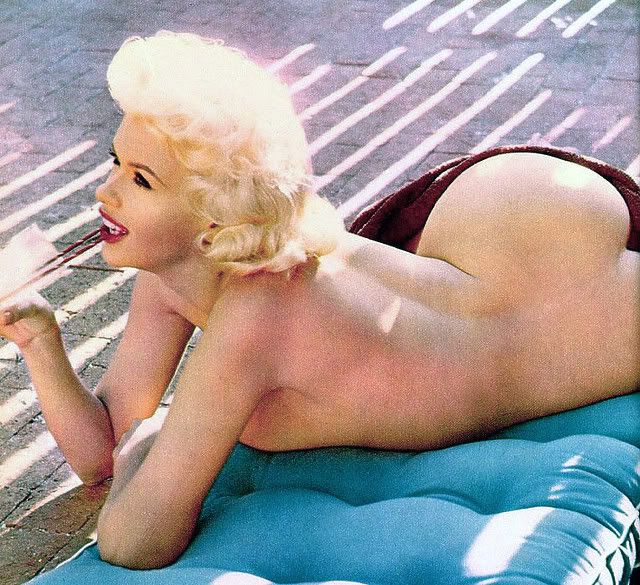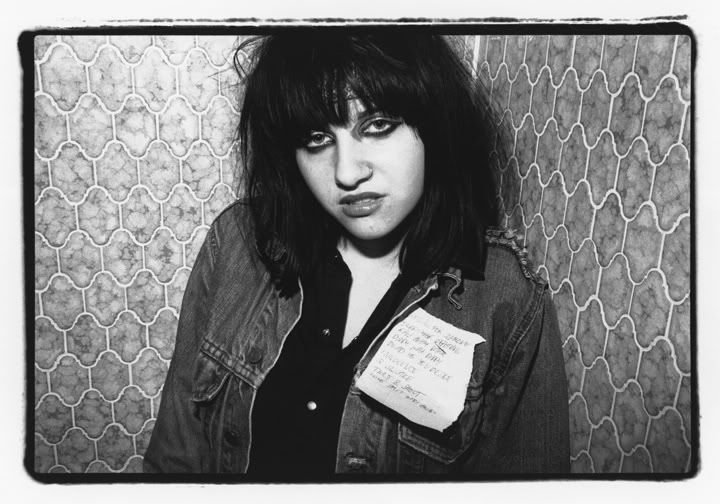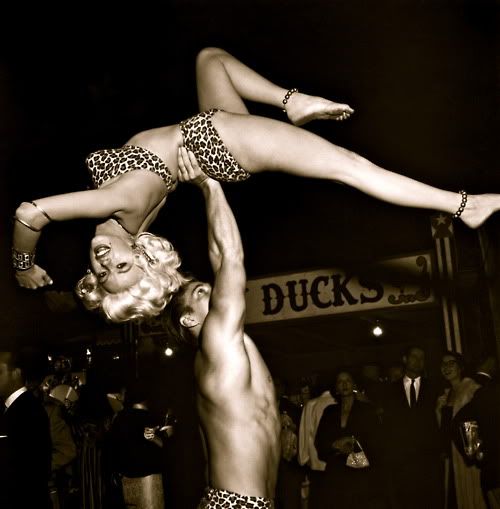
Jayne Mansfield letting it all hang out
This was the first Dr Sketchy back at the Royal Vauxhall Tavern since July. The two previous Dr Sketchy’s at The RVT had been marred by some truly catastrophic technical glitches (fuses blowing, performers’ CDs malfunctioning at crucial moments. You can read about them here and here if you really want to re-visit the full horror). The whole day leading up to this Dr Sketchy I was so anxious about either sound or lights going tits-up again this time that by the time I arrived at The RVT I was acting all twitchy and bug-eyed like Natalie Portman in Black Swan. And just to crank up the pressure, the actual founder of Dr Sketchy, Molly Crabapple from New York, was in town and would be in attendance. (In other words, the actual Queen Mutha of Dr Sketchy herself!). Nothing could wrong!
In fact this Dr Sketchy turned out to be not just smooth and problem-free, it was actually pretty damn triumphant. The night had long been sold-out in advance and was filled to capacity (which always makes things feel buzzing and more fun) with a quite liquored-up and rowdy crowd (suitably, the theme for this Dr Sketchy was “indulgence”). There was cabaret and burlesque aristocracy both onstage and off: the emcee this time was Ophelia Bitz; the featured striptease artiste / model was Cherry Shakewell; Trixi Tassels was working the door and an off-duty Ava Iscariot was in the audience. Throughout the night Molly Crabapple was drawing a gigantic mural / backdrop along the back wall of the RVT stage (the way the DJ booth is situated at The RVT means I couldn’t actually see her art work until the end of the night, but it was pretty freaking amazing).
As usual, the effervescent Ophelia Bitz was the hostess with the mostest. “I’m dressed like a 1960s art teacher” she explained (her beatnik-inspired ensemble involved Capri pants – or toreador pants if you prefer – and a headscarf, with paint brushes sticking out of her hair). Inspired, while Ophelia did some warm-up poses before Cherry Shakewell came out I played “A Cruise to the Moon“ from the timelessly alluring 1979 death jazz album Queen of Siam by the then-19 year old Lydia Lunch when she was the perma-scowling Death Kitten of New York's No Wave scene. Variously described as “a Billie Holiday nightmare” and “a putrid classic of style and substance”, Queen of Siam first well and truly corrupted me when I bought it at a second-hand record store as a teenager and it remains a touchstone of mine to this day. (Around the same time I interviewed Lydia herself for the first time for my university’s newspaper – now that was an education. She taught me about champagne enemas). "A Cruise to the Moon" is actually an instrumental, an epic of discordant art-y big band beatnik jazz-punk -- and was arranged by Billy Ver Planck (the composer of The Flintstones’s theme song!). (I also played a track by Lunch's No Wave contemporary and former partner in crime: a spikey deconstruction of Gene Pitney's "Town without Pity" by James Brown/Chet Baker hybrid James Chance).

She's In a Bad Mood: Lydia Lunch around the time she would have recorded Queen of Siam (1979)
Perennial Dr Sketchy favourite Cherry Shakewell works an irresistible 1960s go-go dancer / babydoll image (think Lori Williams as Billie in Faster, Pussycat! Kill! Kill!) which always prompts me to go full tilt-boogie on 60s sex kitten tracks (Ann-Margret, Nancy Sinatra and Brigitte Bardot). When it comes to lechery, Dr Sketchy operates an equal opportunities policy: we also featured the male model Luscious Luke (he’s aptly-named). I had some tracks cued for his first pose, but as soon as he came onstage and I saw his outfit (pretty much nothing but a pair of black leather hotpants, wielding a spanking paddle in his hand) I quickly replaced them with some S&M-tinged instrumentals ("The Whip by The Originals, "The Whip" by The Frantics, "Torture Rock" by The Rockin' Belmarx).
Soundtracks by David Lynch and John Waters are a constant source of inspiration for me. While I spun the slinky instrumental “The Beast” by Milt Buckner (used in Mulholland Drive), I pondered the folly of David Lynch's much-hyped new nightclub venture Club Silencio in Montmartre in Paris (based on the nightclub of the same name in Mulholland Drive, the one where the woman sings Roy Orbison’s “Crying” en Espanol). While the idea of an eerie and seductive Lynchian nightclub experience makes my nipples harden in ecstasy, it’s hypocritical to describe Club Silencio as a potential successor to Andy Warhol’s Factory, as a Guardian journalist has proposed. At the Factory (at least initially) its genuinely bohemian open door policy meant low-life denizens like junkies, hustlers and drag queens could mingle, flirt and get stoned with socialites, Hollywood stars and Tennessee Williams. Club Silencio meanwhile is a member’s only club – and the most basic membership starts at an eye-watering 780 Euros a year (420 Euros for under-30s and non-French residents). Somehow I think I won’t be checking it out next time I’m in Paris! (I think the pricey and elitist membership fees are designed to weed-out the likes of me, anyway). And anyway, it would have been far cooler to base a nightclub on The Slow Club, the dive bar where Dennis Hopper listens to poor Isabella Rossellini croon her endless, tuneless Nico-like dirge rendition of Blue Velvet.
A few months back Cherry Shakewell Facebooked me asking for urgent help finding suitable music for a new routine she was working on with a cavewoman/ primitive vibe. Honestly -- so demanding! What a diva! Two songs that instantly popped into my head were "Watusi Zombie" by Jan Davis and “Primitive” by The Groupies – and she wound up using both. While I didn’t play “Primitive” at this Dr Sketchy (it’s too 1960s garage punk for the Dr Sketchy vibe), I just found this clip on Youtube – so I guess my idea of using this track for a burlesque number wasn’t quite so original after all! Still – Blaze Starr. What a beauty, and it's this installment's tittyshaker.
Town without Pity - James Chance
Pas c'est chanson - Johnny Holliday
Unchain My Heart - Florence Joelle's Kiss of Fire
Love Letters - Ike and Tina Turner
Follow the Leader - Wiley Terry
The Greasy Chicken - Andre Williams
Club Delight - Jack Jolly
Take Half - Hal Singer
Hole in My Heart - Esquerita
Vesuvius - The Revels
Where Yo Is? Fat Daddy Holmes
Sick and Tired - Lula Reed
Rockin' Out the Blues - The Musical Linn Twins
Trouble - Jackie De Shannon
Don't Be Cruel - Bill Black Combo
Hound Dog - Little Esther
Jungle Walk - The Dyna-Sores
Virgenes del Sol - Yma Sumac
Cha Cha Cha du loup - Serge Gainsbourg
Babydoll Mambo - Belmonte & His Afro-American Music
Love for Sale - Hildegard Knef
Java Partout - Juliette Greco
Lunar Rhapsody - Les Baxter
Ole Devil Moon - Chet Baker
Always True to You in My Fashion - Denise Darcel
Astrosonic - Jimmy Haskell and His Orchestra
A Cruise to the Moon - Lydia Lunch
Pop Slop - Béla Sanders und Sein Tanzorchester
Cherry - The Jive Bombers
Screwdriver - Luchi
Womp Womp - Freddie and The Heartaches
Black Coffee - Julie London
Beat Party - Ritchie and The Squires
Crank Case - Bill Black Combo
Lightning's Girl - Nancy Sinatra
Harley-Davidson - Brigitte Bardot
The Rat - The Ventures
Bombie - Johnny Sharp and The Yellow Jackets
Dragon Walk - The Noble Men
Eight Ball - The Hustlers
The Whip - The Frantics
Rigor Mortis - The Graveyard Four
Torture Rock - The Rockin' Belmarx
Ice Man - Filthy McNasty
Tony's Got Hot Nuts - Faye Richmonde
Love Potion # 9 - Nancy Sit
Beat Out My Love - Lee Dresser and The Krazy Kats
Peter Gunn Twist - The Jesters
Peter Gunn Locomotion - The Delmonas
Peter Gunn Mambo - Jack Costanzo and His Orchestra
Work Song - Nina Simone
Beauty is Only Skin Deep - Robert Mitchum
La Bamba - Eartha Kitt
Mambo Baby - Ruth Brown
She Wants to Mambo - Johnny Thunders and Patti Paladin
The Swinger - Ann-Margret
Sexe - Rene Linaude
The Girl Who Invented Rock'n'Roll - Mamie van Doren
As the Clouds Drift By - Jayne Mansfield
The Beast - Milt Buckner
Makin' Out - Jody Reynolds
Let's Go Sexin' - James Intveld (A Dirty Shame soundtrack)
Little Boy, Little Girl - John and Jackie
Hot Licks - The Rendells
Charge It - The Playboys
Intoxica - The Revels
My Daddy Rocks Me - Mae West
Drive Daddy Drive - Little Sylvia
Kruschev Twist - Melvin Gayle
Ring of Fire - The Earls of Suave
The Girl Can't Help It - Little Richard
Surfin' Snow Matador - Jan Davis
Fever - Timi Yuro
One last grumble: I looked back at some older blogs of mine and discovered that at least 40% of the Youtube videos I'd lovingly chosen to illustrate blog entries have been deleted! They're now just blank black boxes. The standard reasons seem to be the user has deleted their Youtube profile (which means their videos vanish), or (in my case) Youtube has changed its policy on nudity and sexual content. Go check some of your own older blogs and feel instantly discouraged!
Bonus tittyshaker! Jayne Mansfield rocks it out in the wigged-out, floor-writhing dance sequence from Primitive Love (1964)
NOTE: A very talented photographer called Derek Bremner was taking excellent photos at this Dr Sketchy all night long. Check out his blog to see them. I highly recommend you do. The shots of Cherry Shakewell "spanking" Luscious Luke are my favourite.







































